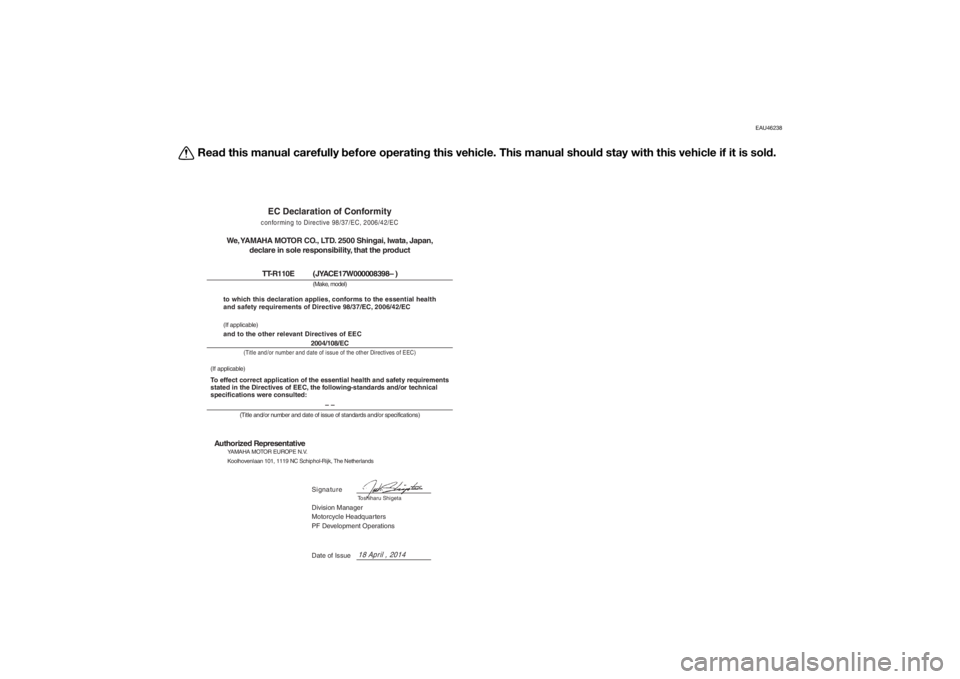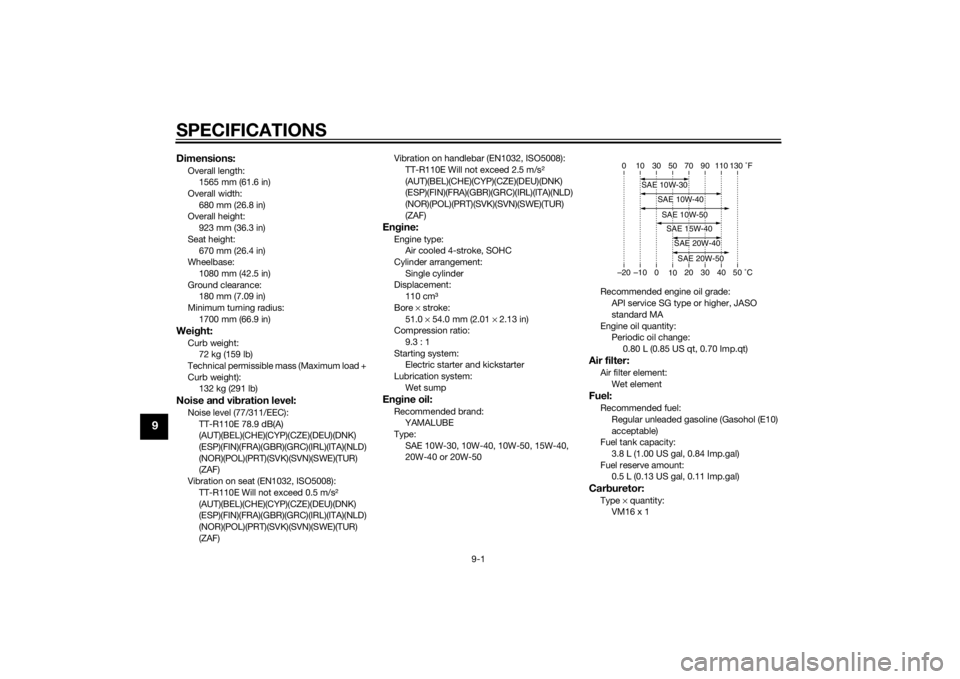ESP YAMAHA TT-R110E 2015 Owners Manual
[x] Cancel search | Manufacturer: YAMAHA, Model Year: 2015, Model line: TT-R110E, Model: YAMAHA TT-R110E 2015Pages: 88, PDF Size: 2.09 MB
Page 4 of 88

EAU46238
Read this manual carefully before operatin g this vehicle. This manual shoul d stay with this vehicle if it is sol d.
EC Declaration of Conformityconforming to Directive 98/37/EC, 2006/42/EC
We, YAMAHA MOTOR CO., LTD. 2500 Shingai, Iwata, Japan,
declare in sole responsibility, that the product
TT-R110E (JYACE17W000008398– )
(Make, model)2004/108/EC
(Title and/or number and date of issue of the other Directives of EEC)
to which this declaration applies, conforms to the essential health
and safety requirements of Directive 98/37/EC, 2006/42/EC(If applicable)and to the other relevant Directives of EEC
(If applicable)To effect correct application of the essential health and safety requirements
stated in the Directives of EEC, the following-standards and/or technical
specifications were consulted:
(Title and/or number and date of issue of standards and/or specifications)
Authorized Representative
YAMAHA MOTOR EUROPE N.V.
Koolhovenlaan 101, 1119 NC Schiphol-Rijk, The Netherlands
Signature
Toshiharu Shigeta
– –
Date of Issue
18 April , 2014
Division Manager
Motorcycle Headquarters
PF Development Operations
UB5180E0.book Page 1 Monday, June 9, 2014 1:20 PM
Page 13 of 88

LOCATION OF IMPORTANT LABELS1-3
1
For Cana
da
3JK-82377-00
This spark ignition system meets all requirements
of the Canadian Interference Causing Equipment
Regulations.
Ce système d’allumage par étincelle de véhicule
respecte toutes les exigences du Règlement sur le
matériel brouilleur du Canada.
THIS VEHICLE IS A RESTRICTED USE
MOTORCYCLE AND IS NOT INTENDED FOR
USE ON PUBLIC HIGHWAYS.
CE VÉHICULE EST UNE MOTOCYCLETTE À
USAGE RESTREINT DONT L’USAGE N’EST PAS
DESTINÉ AUX VOIES PUBLIQUES.
3PT-2416E-10
3PT-2118K-A1
56
8
7
UB5180E0.book Page 3 Monday, June 9, 2014 1:20 PM
Page 20 of 88

2-1
2
SAFETY INFORMATION
EAU4121C
Be a Responsible Owner
As the vehicle’s owner, you are re-
sponsible for the safe and proper oper-
ation of your motorcycle.
Motorcycles are single-track vehicles.
Their safe use and operation are de-
pendent upon the use of proper riding
techniques as well as the expertise of
the operator. Every operator should
know the following requirements be-
fore riding this motorcycle.
He or she should: Obtain thorough instructions from
a competent source on all aspects
of motorcycle operation.
Observe the warnings and mainte-
nance requirements in this Own-
er’s Manual.
Obtain qualified training in safe
and proper riding techniques.
Obtain professional technical ser-
vice as indicated in this Owner’s
Manual and/or when made neces-
sary by mechanical conditions.
Never operate a motorcycle with-
out proper training or instruction.
Take a training course. Beginners
should receive training from a cer-
tified instructor. Contact an autho-
rized motorcycle dealer to find out
about the training courses nearest
you.
Safe Ri din g
Perform the pre-operation checks
each time you use the vehicle to make
sure it is in safe operating condition.
Failure to inspect or maintain the vehi-
cle properly increases the possibility of
an accident or equipment damage.
See page 5-1 for a list of pre-operation
checks. This motorcycle is designed for
off-road use only, therefore, it is il-
legal to operate it on public
streets, roads, or highways, even
a dirt or gravel one. Off-road use
on public lands may be illegal.
Please check local regulations be-
fore riding.
This motorcycle is designed to
carry the operator only. No pas-
sengers.
The failure of motorists to detect
and recognize motorcycles in traf-
fic is the predominating cause of
automobile/motorcycle accidents.
Many accidents have been
caused by an automobile driver
who did not see the motorcycle.
Making yourself conspicuous ap-
pears to be very effective in reduc-
ing the chance of this type of
accident.
Therefore:
• Wear a brightly colored jacket.
• Use extra caution when you are approaching and passing
through intersections, since in-
tersections are the most likely
places for motorcycle accidents
to occur.
• Ride where other motorists can see you. Avoid riding in another
motorist’s blind spot.
• Never maintain a motorcycle without proper knowledge.
Contact an authorized motorcy-
cle dealer to inform you on ba-
sic motorcycle maintenance.
Certain maintenance can only
be carried out by certified staff.UB5180E0.book Page 1 Monday, June 9, 2014 1:20 PM
Page 23 of 88

SAFETY INFORMATION
2-4
2
products or having other modifications
performed to your vehicle that change
any of the vehicle’s design or operation
characteristics can put you and others
at greater risk of serious injury or
death. You are responsible for injuries
related to changes in the vehicle.
Keep the following guidelines in mind,
as well as those provided under “Load-
ing” when mounting accessories.
Never install accessories that
would impair the performance of
your motorcycle. Carefully inspect
the accessory before using it to
make sure that it does not in any
way reduce ground clearance or
cornering clearance, limit suspen-
sion travel, steering travel or con-
trol operation.
• Accessories fitted to the han- dlebar or the front fork area can
create instability due to improp-
er weight distribution. If acces-
sories are added to the
handlebar or front fork area,
they must be as lightweight as
possible and should be kept to
a minimum. • Bulky or large accessories may
seriously affect the stability of
the motorcycle. Wind may at-
tempt to lift the motorcycle, or
the motorcycle may become
unstable in cross winds.
• Certain accessories can dis- place the operator from his or
her normal riding position. This
improper position limits the
freedom of movement of the
operator and may limit control
ability, therefore, such accesso-
ries are not recommended.
Use caution when adding electri-
cal accessories. If electrical ac-
cessories exceed the capacity of
the motorcycle’s electrical sys-
tem, an electric failure could re-
sult, which could cause a
dangerous loss of lights or engine
power.
Aftermarket Tires an d Rims
The tires and rims that came with your
motorcycle were designed to match
the performance capabilities and to
provide the best combination of han-
dling, braking, and comfort. Other tires, rims, sizes, and combinations
may not be appropriate. Refer to page
7-15 for tire specifications and more in-
formation on replacing your tires.
Transportin
g the Motorcycle
Be sure to observe following instruc-
tions before transporting the motorcy-
cle in another vehicle. Remove all loose items from the
motorcycle.
Check that the fuel cock (if
equipped) is in the “OFF” position
and that there are no fuel leaks.
Point the front wheel straight
ahead on the trailer or in the truck
bed, and choke it in a rail to pre-
vent movement.
Shift the transmission in gear (for
models with a manual transmis-
sion).
Secure the motorcycle with tie-
downs or suitable straps that are
attached to solid parts of the mo-
torcycle, such as the frame or up-
per front fork triple clamp (and not,
for example, to rubber-mounted
handlebars or turn signals, or
parts that could break). Choose
UB5180E0.book Page 4 Monday, June 9, 2014 1:20 PM
Page 40 of 88

OPERATION AND IMPORTANT RIDING POINTS
6-1
6
EAU15952
Read the Owner’s Manual carefully to
become familiar with all controls. If
there is a control or function you do not
understand, ask your Yamaha dealer.
WARNING
EWA10272
Failure to familiarize yourself with
the controls can lead to loss of con-
trol, which coul d cause an acci dent
or injury.
EAU44815
Startin g an d warmin g up a
col d en gine1. Turn the fuel cock lever to “ON”.
2. Turn the key to “ON” and make
sure that the engine stop switch is
set to “ ”.
3. Shift the transmission into the neutral position.
WARNING
EWA14411
Be sure to shift the transmission
into neutral b efore starting the
en gine.
Never ri de with the si destan d
d own.4. Turn the starter (choke) on and
completely close the throttle. (See
page 4-7.)
5. Start the engine by pushing the start switch or by pushing the
kickstarter lever down.
6. When the engine is warm, turn the starter (choke) off.
TIPThe engine is warm when it responds
quickly to the throttle with the starter
(choke) turned off.NOTICE
ECA11043
For maximum en gine life, never ac-
celerate har d when the en gine is
col d!
UB5180E0.book Page 1 Monday, June 9, 2014 1:20 PM
Page 42 of 88

OPERATION AND IMPORTANT RIDING POINTS
6-3
63. Open the throttle gradually.
4. Once the motorcycle has reached
a speed high enough to change
gears, close the throttle.
5. Shift into second gear and release the shift pedal.
6. Open the throttle gradually.
7. Follow the same procedure when shifting to the next higher gear.
EAU16711
To decelerate
1. Close the throttle and apply both the front and the rear brakes to
slow the motorcycle.
2. Downshift through the gears and shift the transmission into the neu-
tral position when the motorcycle
is almost completely stopped.
EAU39921
Engine break-inThere is never a more important period
in the life of your engine than the first 5
hours of riding. It is also important to
accustom the rider to the motorcycle
during this time. Please read the fol-
lowing information carefully.
Since the engine is brand new, do not
put an excessive load on it for the first
5 hours of operation. The various parts
in the engine wear and polish them-
selves to the correct operating clear-
ances. During this period, prolonged
full-throttle operation or any condition
that might result in engine overheating
must be avoided. However, momen-
tary full-throttle operation under load
(i.e., two to three seconds maximum)
does not harm the engine. Each full-
throttle acceleration should be fol-
lowed with a substantial rest period for
the engine. To allow the engine to cool
down from the temporary buildup of
heat, cruise at a lower engine speed.
After the first 5 hours of operation,
thoroughly check the motorcycle for
loose parts, oil leakage and any other
problems. Be sure to inspect and make adjustments thoroughly, especially ca-
ble and drive chain slack and loose
spokes. In addition, check all fittings
and fasteners for looseness, and tight-
en if necessary.
NOTICE
ECA10271
If any en
gine trou ble shoul d occur
d urin g the en gine break-in perio d,
imme diately have a Yamaha dealer
check the vehicle.
UB5180E0.book Page 3 Monday, June 9, 2014 1:20 PM
Page 65 of 88

PERIODIC MAINTENANCE AND ADJUSTMENT
7-22
7
tion (a). To loosen the drive chain,
turn the adjusting nut at each end
of the swingarm in direction (b),
and then push the rear wheel for-
ward.
NOTICE: Improper drive
chain slack will overload the en-
g ine as well as other vital parts
of the motorcycle an d can lead
to chain slippa ge or b reakage.
To prevent this from occurrin g,
keep the d rive chain slack with-
in the specified limits.
[ECA10572]
TIPUsing the alignment marks on each
side of the swingarm, make sure that
both drive chain pullers are in the same
position for proper wheel alignment.
3. Tighten the axle nut and both
locknuts to the specified torques.
4. Adjust the brake pedal free play. (See page 7-19.)
5. Make sure that the drive chain pullers are in the same position,
the drive chain slack is correct,
and the drive chain moves
smoothly.
EAU23018
Cleanin g an d lu bricatin g the
d rive chainThe drive chain must be cleaned and
lubricated at the intervals specified in
the periodic maintenance and lubrica-
tion chart, otherwise it will quickly wear
out, especially when riding in dusty or
wet areas. Service the drive chain as
follows.NOTICE
ECA10584
The drive chain must b e lubricate d
after washin g the motorcycle, ri din g
in the rain or ri din g in wet areas.1. Remove all dirt and mud from the
drive chain with a brush or cloth.TIPFor a thorough cleaning, have a
Yamaha dealer remove the drive chain
and soak it in solvent.2. Spray Yamaha chain lubricant orother suitable chain lubricant on
the entire chain, making sure that
all side plates and rollers have
been sufficiently oiled.
1. Alignment marks
2. Locknut
3. Drive chain slack adjusting nut
4. Drive chain puller
Tightenin g torques:
Axle nut: 60 Nm (6.0 m·kgf, 43 ft·lbf)
Locknut: 7 Nm (0.7 m·kgf, 5.1 ft·lbf)
(a)
(b)
432 1
UB5180E0.book Page 22 Monday, June 9, 2014 1:20 PM
Page 78 of 88

MOTORCYCLE CARE AND STORAGE
8-1
8
EAU37834
Matte color cautionNOTICE
ECA15193
Some models are equipped with
matte colore d finishe d parts. Be
sure to consult a Yamaha d ealer for
a d vice on what prod ucts to use be-
fore cleanin g the vehicle. Usin g a
b rush, harsh chemical prod ucts or
cleanin g compoun ds when cleanin g
these parts will scratch or damag e
their surface. Wax also shoul d not
b e applied to any matte colore d fin-
ishe d parts.
EAU40466
CareWhile the open design of a motorcycle
reveals the attractiveness of the tech-
nology, it also makes it more vulnera-
ble. Rust and corrosion can develop
even if high-quality components are
used. A rusty exhaust pipe may go un-
noticed on a car, however, it detracts
from the overall appearance of a mo-
torcycle. Frequent and proper care
does not only comply with the terms of
the warranty, but it will also keep your
motorcycle looking good, extend its
life and optimize its performance.
Before cleanin g
1. Cover the muffler outlet with a plastic bag after the engine has
cooled down.
2. Make sure that all caps and cov- ers as well as all electrical cou-
plers and connectors, including
the spark plug cap, are tightly in-
stalled.
3. Remove extremely stubborn dirt, like oil burnt onto the crankcase,
with a degreasing agent and a
brush, but never apply such prod- ucts onto seals, gaskets, sprock-
ets, the drive chain and wheel
axles. Always rinse the dirt and
degreaser off with water.
Cleanin g
NOTICE
ECA10773
Avoi d usin g stron g aci dic wheel
cleaners, especially on spoke d
wheels. If such pro ducts are
use d on har d-to-remove dirt, do
not leave the cleaner on the af-
fected area any lon ger than in-
structe d. Also, thorou ghly rinse
the area off with water, imme di-
ately dry it, an d then apply a cor-
rosion protection spray.
Improper cleanin g can d amage
plastic parts (such as cowlin gs,
panels, win dshiel ds, hea dlig ht
lenses, meter lenses, etc.) an d
the mufflers. Use only a soft,
clean cloth or spon ge with wa-
ter to clean plastic. However, if
the plastic parts cannot b e thor-
ou ghly cleaned with water, di-
lute d mil d d eter gent with water
may be used . Be sure to rinse
UB5180E0.book Page 1 Monday, June 9, 2014 1:20 PM
Page 82 of 88

SPECIFICATIONS
9-1
9
Dimensions:Overall length:1565 mm (61.6 in)
Overall width:
680 mm (26.8 in)
Overall height: 923 mm (36.3 in)
Seat height: 670 mm (26.4 in)
Wheelbase:
1080 mm (42.5 in)
Ground clearance: 180 mm (7.09 in)
Minimum turning radius: 1700 mm (66.9 in)Wei ght:Curb weight:
72 kg (159 lb)
Technical permissible mass (Maximum load +
Curb weight): 132 kg (291 lb)Noise an d vi bration level:Noise level (77/311/EEC):
TT-R110E 78.9 dB(A)
(AUT)(BEL)(CHE)(CYP)(CZE)(DEU)(DNK)
(ESP)(FIN)(FRA)(GBR)(GRC)(IRL)(ITA)(NLD)
(NOR)(POL)(PRT)(SVK)(SVN)(SWE)(TUR)
(ZAF)
Vibration on seat (EN1032, ISO5008):
TT-R110E Will not exceed 0.5 m/s²
(AUT)(BEL)(CHE)(CYP)(CZE)(DEU)(DNK)
(ESP)(FIN)(FRA)(GBR)(GRC)(IRL)(ITA)(NLD)
(NOR)(POL)(PRT)(SVK)(SVN)(SWE)(TUR)
(ZAF) Vibration on handlebar (EN1032, ISO5008):
TT-R110E Will not exceed 2.5 m/s²
(AUT)(BEL)(CHE)(CYP)(CZE)(DEU)(DNK)
(ESP)(FIN)(FRA)(GBR)(GRC)(IRL)(ITA)(NLD)
(NOR)(POL)(PRT)(SVK)(SVN)(SWE)(TUR)
(ZAF)
Engine:Engine type:
Air cooled 4-stroke, SOHC
Cylinder arrangement:
Single cylinder
Displacement: 110 cm³
Bore × stroke:
51.0 × 54.0 mm (2.01 × 2.13 in)
Compression ratio:
9.3 : 1
Starting system: Electric starter and kickstarter
Lubrication system: Wet sumpEngine oil:Recommended brand:
YAMALUBE
Type: SAE 10W-30, 10W-40, 10W-50, 15W-40,
20W-40 or 20W-50 Recommended engine oil grade:
API service SG type or higher, JASO
standard MA
Engine oil quantity: Periodic oil change:
0.80 L (0.85 US qt, 0.70 Imp.qt)
Air filter:Air filter element:Wet elementFuel:Recommended fuel:Regular unleaded gasoline (Gasohol (E10)
acceptable)
Fuel tank capacity: 3.8 L (1.00 US gal, 0.84 Imp.gal)
Fuel reserve amount: 0.5 L (0.13 US gal, 0.11 Imp.gal)Car buretor:Type × quantity:
VM16 x 1
–20 –10 0 1020 30 40 50 �C
10 30 50 70 90 110
0 130 �F
SAE 10W-30
SAE 15W-40SAE 20W-40SAE 20W-50
SAE 10W-40SAE 10W-50
UB5180E0.book Page 1 Monday, June 9, 2014 1:20 PM